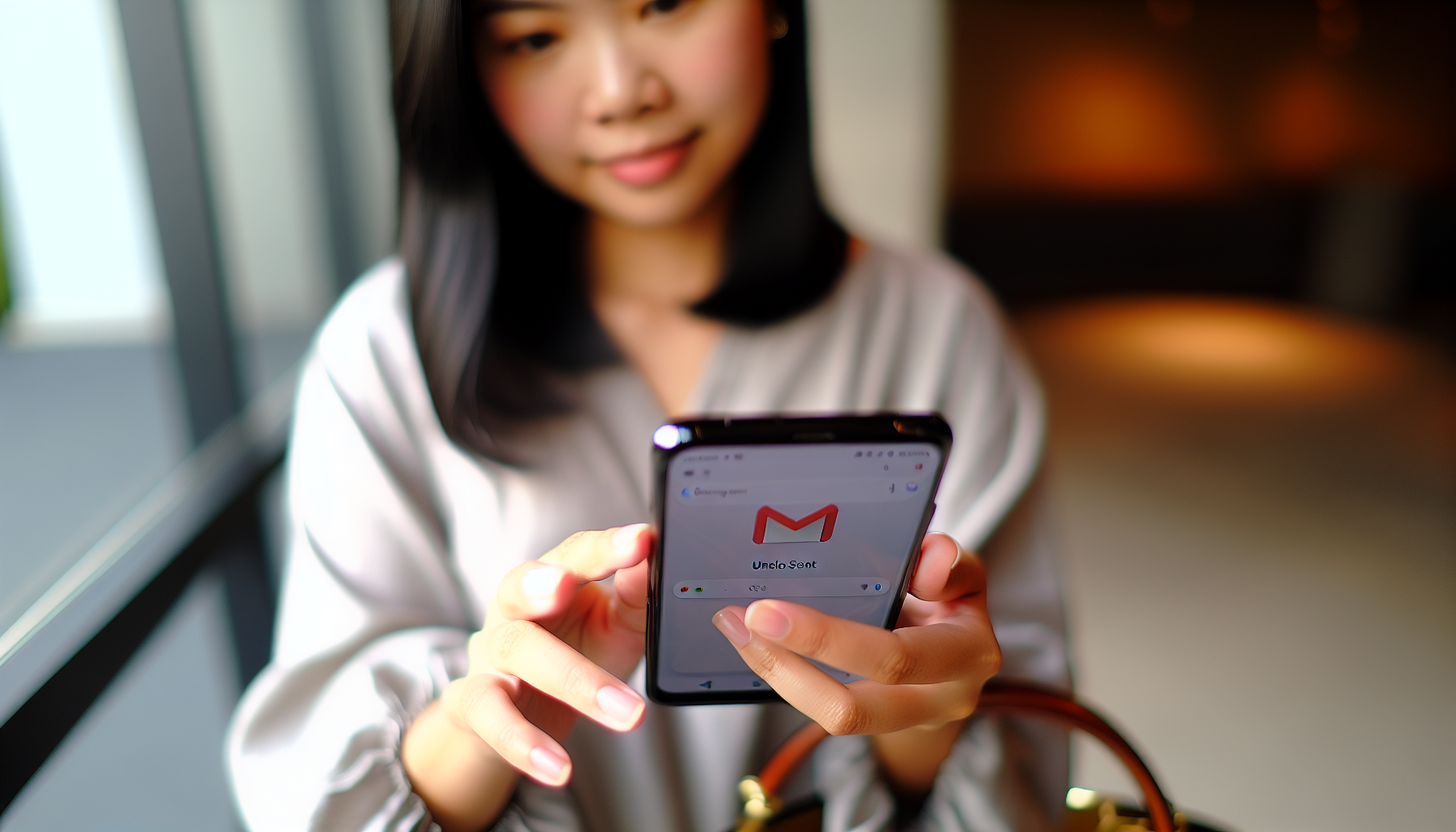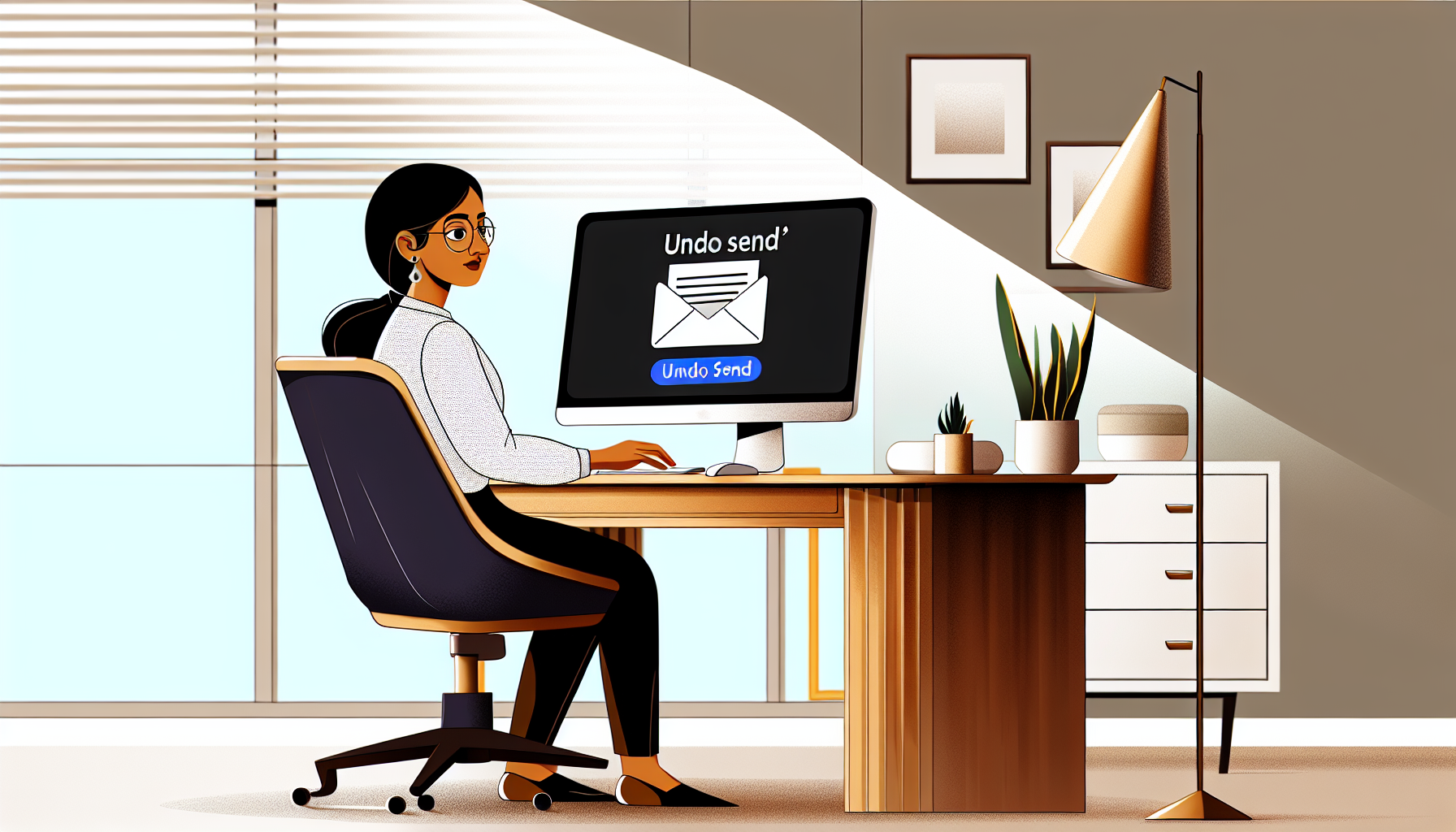In the seconds following an email mishap, knowing how to unsend an email can be a game-changer. Whether you use Gmail, Outlook, or another client, this article guides you through the process to swiftly retracting a sent email.
Key Takeaways
- Gmail and Outlook offer an ‘Undo Send’ feature that allows users to retract an email after sending, with timeframes adjustable up to 30 seconds on Gmail and differing options on Outlook.
- Other email clients like Zoho Mail, Mailbird, and Spark also have their own versions of send delay or unsend features, providing flexibility and additional functionalities for managing emails.
- Preventing email blunders is key, using tools like Grammarly for proofreading, and email management tools like Clean Email to organize your inbox can save you from sending errors.
Mastering the Undo Send Feature in Gmail

Gmail, one of the most widely used email services worldwide, offers a handy feature called “Undo Send” that can potentially save you from embarrassing email blunders. From setting up a cancellation period to actual usage, let’s get you up to speed on mastering this feature to unsend emails.
Activating Undo Send on Gmail Desktop
Initiating the Undo Send feature on Gmail Desktop begins with sending an email. Once you hit send, a little bar pops up at the bottom left of your screen with an ‘Undo’ option next to ‘Message sent’.
By default, you only have 5 seconds to click ‘Undo’. But what if you need more time to enable undo send? To tap undo send delay, simply adjust the settings in your Gmail account.
Well, you’re in luck! Gmail allows you to extend this timeframe. You can set the Undo Send feature to last for as short as five seconds or extend it up to 30 seconds. This gives you a little more time to realize your mistakes and retract that email before it lands in the recipient’s inbox.
Keep in mind that the Gmail Desktop’s Undo Send feature caps at a maximum of 30 seconds. So, you need to act fast if you want to unsend an email. After 30 seconds, the email is officially sent, and there’s no turning back.
Utilizing Undo Send on Gmail Mobile Apps
What if you’re using the Gmail Android app on your mobile device? Is unsending an email still possible? Absolutely! The Undo Send feature is also available on the Gmail app for Android and iOS.
By default, you have a 5-second window to tap ‘Undo’ after sending an email. But, similar to the desktop version, you can extend this duration up to 30 seconds by adjusting the ‘Send cancellation period’ in the settings. This gives you ample time to spot any errors or second thoughts and retract your email before it reaches the recipient.
The Art of Email Recall on Outlook

Let’s now turn our attention to another widely used email client – the Outlook desktop app. Offering a slightly different approach, Outlook provides two options for unsending an email – the Undo Send feature and the more complex Message Recall function. To view message recall options, simply follow the steps provided in the app.
So, how do they function?
Configuring Undo Send on Outlook Web Access
In Outlook Web Access, consider the Undo Send feature as your primary tool for retracting sent emails. But first, you need to activate it. To do so, follow these steps:
- Go to the Settings Icon in the top menu.
- Select ‘View all Outlook Settings’.
- Click on ‘Mail | Compose and Reply’.
- Turn on the ‘Undo Send’ option.
By default, Outlook provides a 10-second window to retract a sent email. But, as with Gmail, you can adjust this duration. You can set it for:
- 5 seconds
- 10 seconds
- 15 seconds
- 30 seconds
This allows you to have more time to spot any errors or changes of heart before the email is sent.
Yet, the Undo Send feature in Outlook Web Access isn’t without its limitations. For instance, you need to manually activate it in the settings. Also, the feature won’t work if the recipient has already opened the email, and the recall feature may not work if the email is sent to a different email system.
Fine-Tuning Send Delay on Outlook for Mac
For Outlook users on Mac, there’s an additional useful tool – the send delay feature. This feature gives you the flexibility to set a specific time and date for your email to be sent.
To adjust the send delay, click on the Send button, select ‘Send Later’, enter your desired delay time, and hit Send. Your email will then be saved in the Drafts folder until the specified time.
This feature is great for preventing impulsive email sending and ensuring your emails are complete and polished before they land in the recipient’s inbox.
Navigating Unsend Options in Other Email Clients

While Gmail and Outlook are among the most recognized email clients, they are not the only ones that offer unsend options. Other email clients, like Zoho Mail, also offer similar features. Let’s explore these alternatives.
Exploring Zoho Mail’s Send Delay
Zoho Mail provides a feature called Outbox Delay, which allows you to delay outgoing email messages by setting a specific time frame. You can set this delay from 1 minute to 120 minutes, giving you ample time to unsend an email if you spot an error or change your mind.
To activate it, head to Settings, then Mail, followed by Compose & Reply, and turn on the ‘Enable Outbox’ option. If you need to recall an email within the delay time you’ve set, simply go to your Sent folder, click on the Mail Delivery Status (MDS) icon, and choose the recall option in the Mail delivery pop-up.
The Power of Third-Party Email Clients
For more flexibility and functionality, consider exploring third-party email clients such as Mailbird and Spark. These clients offer unsend features that are compatible with various email services, not just one.
Mailbird offers several useful features for managing your emails, including:
- The ability to unsend an email by clicking the Undo button that pops up after you hit send
- Customizable workspaces
- AI-powered email writing
- Seamless app integration
These features make Mailbird a powerful tool for managing your emails.
Spark offers several useful features, including:
- Send delay feature: You can access this feature by going to Spark Settings, choosing Scheduling > Send Later, and setting the time for the email to be sent.
- Unified inbox: Spark has a unified inbox that allows you to view all your emails from different accounts in one place.
- Smart search: Spark has a smart search feature that makes it easy to find specific emails or attachments.
These features, including the drop-down menu, can help you manage your email messages more efficiently on your Microsoft Exchange Server.
Tips to Prevent Email Blunders Before Hitting Send

Even though unsend features are beneficial, the optimal way to avoid errors in outgoing email messages is to prevent them altogether.
Before hitting send, always double-check your recipients and attachments, and proofread your content. Tools like Grammarly, Hemingway App, and Hemingway Editor can help you spot and fix any errors in your emails.
But what happens when your inbox is flooded, and you’re managing several threads simultaneously? That’s where email management tools come in handy.
Clean Email, for instance, organizes and prioritizes your emails, saving you from the stress of email overload. This tool works with various email providers and offers features like automatic sending and neat categorization of your emails.
Another useful advice is to take a moment before pressing send. This gives you time to review your email one last time, spotting any errors or missed attachments. Remember, it’s always better to spend an extra minute reviewing your email than to hastily send it and risk making a mistake.
Summary
In conclusion, the ability to unsend an email is a lifesaver in today’s fast-paced digital world. Whether you’re using Gmail, Outlook, Zoho Mail, or third-party clients like Mailbird and Spark, mastering the unsend feature can save you from embarrassing email blunders.
So, take a moment to familiarize yourself with these features, double-check your emails before hitting send, and keep your inbox organized. After all, a little caution goes a long way in the world of email communication.
Frequently Asked Questions
How do I Unsend an email I already sent?
After sending an email, you can click “Undo” in the bottom left corner where it says “Message sent” to retract it in Gmail. Just act quickly to take advantage of this feature.
Can you Unsend an email after an hour?
No, you can’t unsend an email in Gmail after one hour. Once the email is sent, there’s no way to recall it, so it’s important to double-check before hitting send.
Can I delete an email I sent?
Yes, you can delete an email you sent by going to your “Sent” folder and selecting the email you want to delete, then clicking on the “Delete” button. If you’re using Gmail, the conversation is moved to the bin; in Outlook, it is moved to the recoverable items.
Is it possible to Unsend an email to Outlook?
Yes, it is possible to unsend an email in Outlook. Simply open the “Sent Items” folder, double-click on the email, go to “Message,” click on “Actions,” and select “Recall This Message.”
Are there any limitations to the unsend feature?
Yes, there are limitations to the unsend feature. For instance, in Outlook, the recall feature only works if both the sender and recipient are using Microsoft 365 or Microsoft Exchange Server in the same organization. It also won’t work if the recipient has already opened the email.
